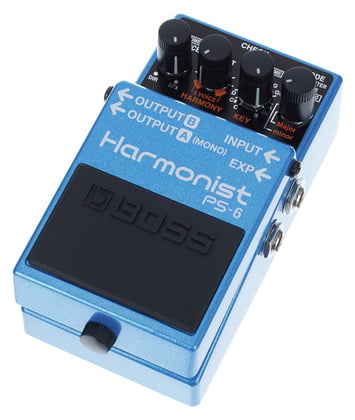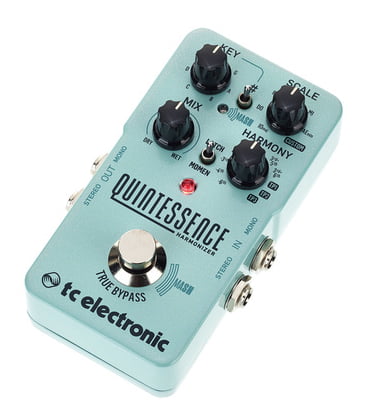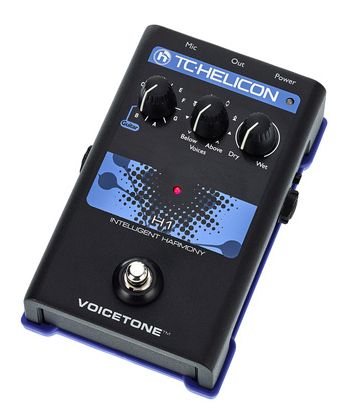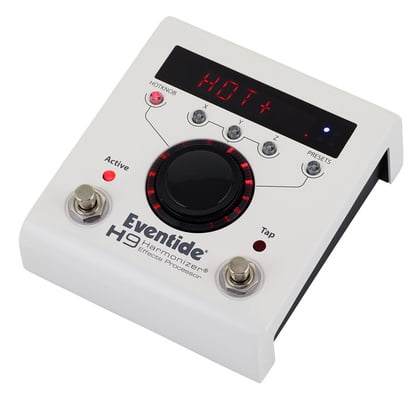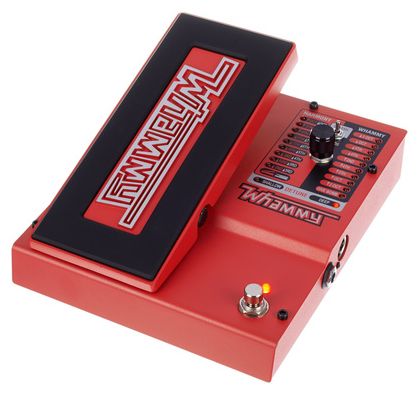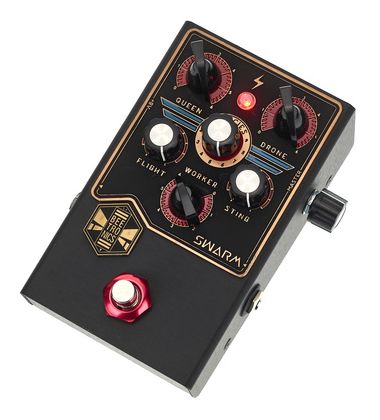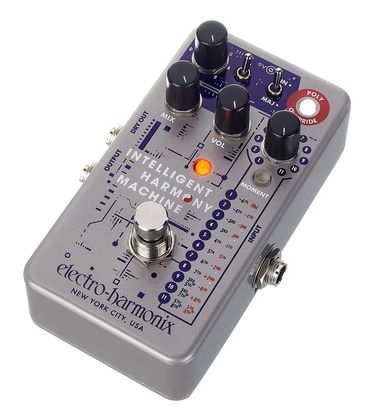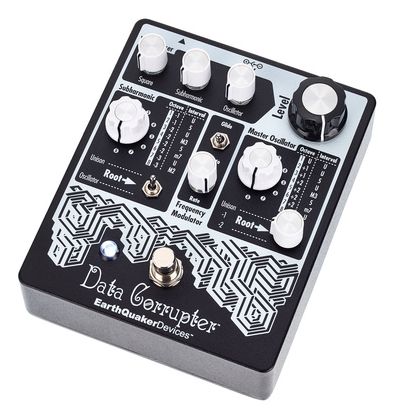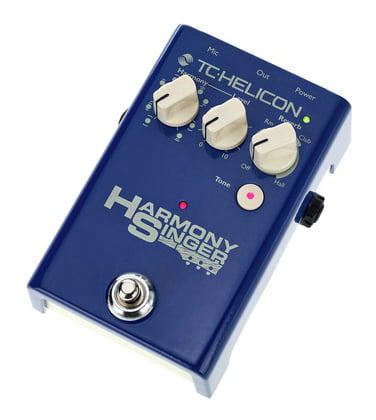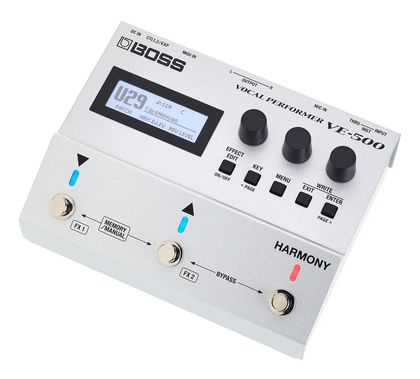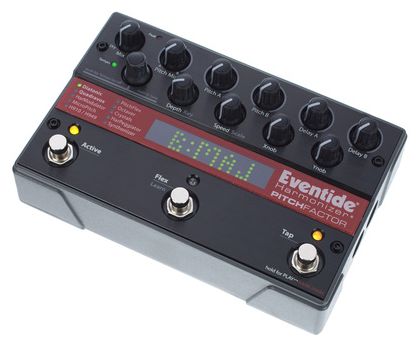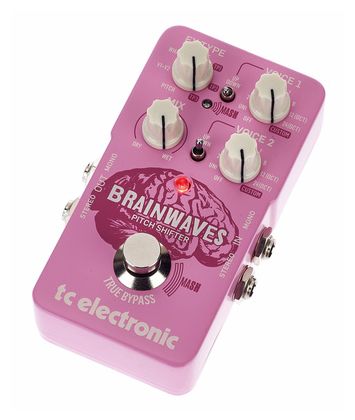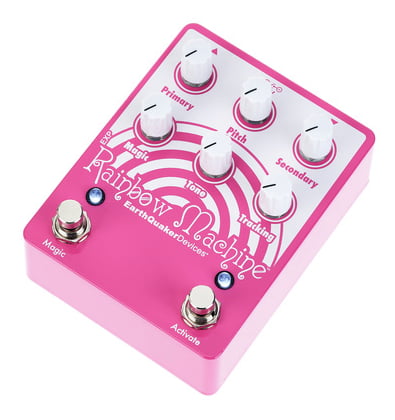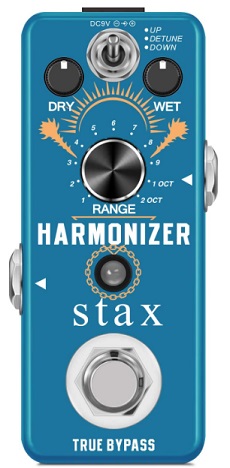This article will discuss the different harmonizer pedals you can use with your guitar, including how you can use them to your advantage to thicken your sound or create new tones.
If you’re looking to recreate those licks from The Boys are Back in Town by Thin Lizzy, Judas Priest’s Heading out on the Highway, or even Iron Maiden’s The Trooper, but are lacking guitar players in your band, then you need a harmonizer pedal.
The riffs and solos of these songs featured guitar harmonies played by different players on the track. These licks are played note for note and replicated to create that harmonious tone of multiple players playing the same thing.
How does Harmonizer Guitar Pedal Work?
A harmonizer pedal copies the notes you play and plays them back with your original signal at a different pitch. So, for example, if you play a C note on your fretboard, the Harmonizer plays back a different note, such as F, depending on how you set the harmonizer pedal.
The original signal and the affected signal create a harmonized signal. You can then tweak the harmonized signal to increase or decrease the copied or original signal.
How to Use the Harmonizer pedal?
Assuming that you’re not making any crazy and experimental sounds with your guitar, the first thing you need to do when using a harmonizer pedal is to ensure that your guitar is in tune. And that includes having your guitar intonated.
It’s important that your guitar is in tune and intonated because the harmonizer pedal will copy that signal and shift it to the number of steps you set it to. The harmonized signal will also be slightly sharp or flat if your guitar is slightly sharp or flat on the 12th fret.
Once your guitar is intonated, you can set the number of steps you want the Harmonizer to play. Many harmonizer pedals offer step increments, an octave above or below, with semitones in between. Then you should set the blend or dry signal vis-à-vis the harmonized signal.
You can set the harmonized signal higher than the original signal, but this may sound too artificial. Some harmonizers let you set how many “voices” or harmonized signals come from the pedal. Set this based on what you think works for the song you’re playing.
Where should you put a Harmonizer Pedal in your signal chain?
Harmonizers are pitch-shifting pedals, often placed at the beginning of the signal chain. As a guide to help you start with harmonizers, it’s good to start here. But there are no rules that need to be followed in finding where your Harmonizer should be, unlike plugging your pedalboard into a mixer or direct into your speaker cabinet, which can cause some damage if not done properly.
At the end of the day, you should put the harmonizer pedal wherever it works best for your songs. Some people like them after overdrives and distortions or before delay and reverb processors. Don’t just stick to one place; try and experiment with which works for you.
How does a Harmonizer Pedal differ from Chorus, Octave, and Pitch Shifting effects?
A Harmonizer pedal recreates in perfect pitch with little latency the signal from your guitar, while a chorus pedal recreates the signal and slightly down-tunes the playback signal. Meanwhile, an octave pedal can only create harmonized signal based on octaves.
Harmonizer pedals, aside from playing octaves, can also recreate signals that are semitones or steps above or below the original notes. Harmonizers have a better range when note harmonizing, as it is not limited to octaves.
Lastly, a pitch shifter raises a pitch based on the number of semitones you set it to and plays it as it is, while a harmonizer plays a shifted pitch alongside the original signal.
Now it’s worth noting that some harmonizers also have pitch-shifting functions. In some cases, you can set the signal to completely wet or no dry signal to get a pitch-shifting sound, but it will sound less natural compared to a guitar string played in that tuning.
Top 14 Harmonizer Guitar Pedals 2024 (Best Rated on Any Budget)
1. Boss Harmonist PS-6 (Harmonizer/Pitch Shifter)
When it comes to guitar pedals in general, Boss remains one of the most popular brands. This is because it covers almost all effects, with a price tag in the middle of the whole spectrum of guitar pedals.
For harmonizing sounds, Boss offers the Harmonist PS-6. The Boss PS-6 is a compact harmonizer and pitch shifter pedal that should fit easily in your pedalboard.
Out of the box, you’ll first notice that the Boss PS-6 uses the same durable enclosure that Boss pedals are known for.
Key Features:
The Boss PS-6 features a harmonizer and pitch shifter in a single-pedal format. Four knobs control the functions of the harmonizer and pitch shifter, depending on what mode you select.
- Balance/Rise Time
The Balance blends your dry signal with the effected sound. For the Harmonizer function, you use this knob to balance how much of the harmonized signal is heard. In S-Bend mode, this control sets the time it takes to switch to the pitch-shifted sound.
- Shift/Harmony
In Harmonizer mode, the Shift knob sets the increments of the harmony produced. In other modes, the Shift sets the pitch the pedal will move to.
- Key/Fall Time
When in Harmonizer mode, this knob sets the key the harmonies will be played in, which is why it’s important to have a properly tuned guitar so that the harmonies come out correctly. In S-Bend mode, this knob sets the time to return to the original pitch.
- Mode
This knob sets how the pedal will function. Here, there are two kinds of harmonies (Major and minor scale), a detune mode, pitch shift, and S-Bend settings, which will dictate how the other knobs function.
- Optional Expression Pedal Input
Plugging an optional expression pedal allows you to control pitch-shifting values without reaching for the pedal. This feature is only for the pitch shifter and does nothing on harmony features.
Character & Sound:
The Boss PS-6 has very minimal latency in both functions. The Harmonizer tracks the signal well, and you can expect to recreate those famous harmonized riffs that many glam and hard rock bands are known for.
The same can be said for the Pitch Shifter feature. If you do live-looping and you need a bass sound, you can easily emulate a lower octave using this pedal to create basslines for a looping performance.
Pros:
You can expect everything that a Boss pedal should be in the PS-6. It’s built like a tank with its metal enclosure; it’s compact and fits easily in your pedal board. The stereo outputs also help you separate your original signal from your harmonized sound if you have two amps available for a more realistic feel.
For the sound quality, you can’t go wrong with the PS-6 as it has very minimal latency and does a good job of mimicking harmonized lead lines. This pedal is very musical as long as your instruments are in tune.
Cons:
There’s a slight learning curve with this pedal. While you get a lot of controls for the Harmonizer, it takes some memorizing to know what you’re doing with the pedal. And because you need to set the song’s key, that’s another thing you must remember when using this pedal.
Another thing worth noting is that the Boss PS-6’s Harmonizer doesn’t do chords well, which is expected, as harmonizers were designed to track single notes. It does, however, sound okay with chords when in pitch shifter mode.
2. TC Electronic Quintessence Harmony
The TC Electronic Quintessence Harmony pedal offers wider note tracking and memory options. In addition, the Quintessence is designed in a compact stompbox pedal, easily fits many pedalboards, and delivers impressive tracking with minimal latency.
The Quintessence is part of TC Electronic’s product line that features Tone Print, which allows you to download and edit presets from the TC Electronic website.
Key Features:
One of the interesting features of the Quintessence is the MASH footswitch, which allows you to turn the pedal into a pitch shifter. It functions like an expression pedal, jumps to the chosen interval when you hold it, and goes back to bypass upon releasing the footswitch.
The knobs of the Quintessence also show how wide the pedal can go in creating harmonies.
- Key Knob
The Key knob allows you to set the key of the harmonies you’ll be playing. A switch also allows you to set the key to a sharp note.
- Mix Knob
This knob controls how much of the harmonized signal gets through the output. Set it in the middle, and you get a 50-50 blend of wet and dry signals.
- Scale Knob
The scale knob offers seven modes you can set to what scale your harmonies will run. The nice thing about this feature is that it’s not limited to major and minor scales and lets you try other scales, such as Phrygian and Lydian, plus one slot for a custom setting.
- Harmony Knob
This control lets you set the voice of your harmonies. There are eight preset harmonies, plus three tone print settings that let you put your settings.
Aside from these features, the Quintessence also features the option of buffered or true bypass, which helps if you need to have a buffer somewhere in the middle of your signal chain.
Character & Sound:
The Quintessence features remarkable tracking that allows the pedal to track notes from the guitar, including fast shreds. As a result, you can create one-of-a-kind solos that take you back to the glam rock era.
Adding more scales gives you options to create harmonies that match different genres. For example, considering the scales available, you can use this to create interesting jazz lines aside from metal.
Pros:
One of the strong points of the Quintessence is the Scale control, which lets you create harmonies outside the usual major and minor scales and create interesting note blends for your songs.
Another plus point is the Tone Print feature, which lets you get custom harmonized settings. You can tweak them with a computer or through the smartphone app. The smartphone app is a good feature as you can make changes during soundcheck without opening your laptop during a gig.
Cons:
If there’s any issue with the Quintessence, it’s the sensitivity of the footswitch. Some players have reported that the MASH sometimes engages by accident due to the sensitivity of the switch when in momentary mode.
Because of this sensitivity, some players have noted switching to pitch shift by accident instead of getting a quick harmonized line. This sensitivity can be a problem for heavy-footed guitar players.
3. TC Helicon VOICETONE H1
The TC Helicon Voice tone H1 is not the usual guitar harmonizer pedal. Unlike other harmonizer pedals that create harmony lines for your guitar, the Voicetone H1 creates harmony lines for your vocals using the notes you play with your guitar.
You can think of the Voicetone H1 as a “clean vocoder,” which produces clear vocal lines based on the notes you play on a guitar, unlike a vocoder, which processes your voice like a synthesizer.
Key Features:
The Voicetone H1 has two inputs for the guitar and microphone and a separate output for the microphone and guitar. There’s also a ground lift switch, should you encounter any hums while operating the pedal.
The fun part is when you tinker with the pedal’s controls to unlock your harmonized tone.
- Key Knob
The Key selector lets you set what key the harmonies you’ll be playing in. Even without a guitar, you can use the key knob to set the scale your harmonies will play.
- Voices
The Voices knob lets you set how close your harmonies are to the original signal. For example, you can set them to play at thirds or as far as fifths or sevenths.
- Mix
The Mix control blends the amount of harmonized signal and the dry signal from the pedal. For example, putting the Mix at 12 o’clock is an equal blend of wet and dry signals.
Character & Sound:
The Voicetone H1 relies heavily on your guitar to create a harmonized sound. It picks up the pitch from your guitar to create harmonies based on the notes it tracks.
While the Voicetone H1 is primarily a vocal harmonizer, you can still use it on guitar. With a direct inject box (DI Box), you can b In addition, you can set the key using the Key knob and create your harmonies with this pedal. While this is possible, the results may vary depending on your guitar.
Pros:
There isn’t much to say about this pedal when it comes to advantages and disadvantages. The Voicetone H1 has built-in phantom power, so you can plug your condenser microphones if you want to create harmonies during a recording session. Using a guitar also helps if you want to keep your harmonies in tune with the instrument.
Cons:
While this pedal works with guitars, it only provides a point of reference for the pedal to track notes. It doesn’t harmonize the guitar unless you plug a DI box into the microphone input. And should you take this route, note that you cannot turn off the phantom power on this pedal, so you’ll need a DI box that uses phantom power.
4. Eventide H9 Max Harmonizer
The Eventide H9 is a multi-effects pedal that features some nifty harmonizing presets. Considering what the H9 can do, we’ll focus on what the Harmonizers can do.
The H9 uses the same algorithm used on the Eventide Pitchfactor. So anything you do on the Pitchfactor is possible with the H9. And because it’s also a multi-effects system, it can also do more.
Key Features:
The H9 features three harmonizing algorithms that you can use to create various lead lines. In addition, you can plug an expression pedal to add more variety to the ones you make.
- Diatonic
The Diatonic algorithm tracks notes and plays them at a key and scale that you select. In addition, the Diatonic provides two independent pitch shifters that adjust to the key you play.
- Quadravox
The Quadravox algorithm is similar to the Diatonic, only that it uses four different shifters. They also come with the same delay and feedback controls as the Diatonic.
- Harmodulator
This algorithm uses twin pitch shifters that play in a chromatic key with modulation. The Harmodulator can go up and down three octaves on each side and may be set for subtle to full-on harmonies.
Character & Sound:
The harmonizers on the H9 Max all feature a delay setting, just like the Pitchfactor. You can use these to create more natural harmonies as if there were at least two more guitar players. You can set these delays to behave differently for a more natural experience.
The Harmodulator, in particular, is also an interesting algorithm. It helps create one-of-a-kind textures you don’t normally get from the usual harmonizer pedal.
Pros:
The H9 Max as a harmonizer pedal goes beyond being a harmonizer and lets you create harmonies that sound like they’re doing their own thing. This can be attributed to the built-in delays you can set for each harmony.
The app control is also a plus for the H9 Max, as you can use it to tweak your harmonies without navigating through the pedal. In addition, you don’t need to dig into menus when using the Eventide app.
Cons:
With the Eventide app, it will be easier to navigate through any of the presets or algorithms of the H9 Max. Unfortunately, this dependence on the app could be more user-friendly.
Another flaw with this pedal is the position of the input and output jacks. While the stereo in and out is much appreciated, it doesn’t follow the usual flow of pedals from right to left. When facing the jack panel, the output jacks are on the front panel’s left side, while the input jacks are on the right side.
5. Digitech Whammy 5
The Digitech Whammy 5 is one of the most historical pedals in guitar history. If you’re familiar with Rage Against the Machine’s Know Your Enemy, that song features one notable application of the Digitech Whammy in harmony mode.
The Digitech Whammy stands out from this list with its Ferrari red chassis and is the only one with an expression pedal. In addition, half of the presets on the Whammy is for harmonization.
Key Features:
Behind the power of the Digitech Whammy is its expression pedal that lets you shift between harmony modes. You can choose from different harmony combinations, which you can rock back and forth to shift harmony modes when the heel or toe is down.
- Classic – Chords Switch
To improve tracking accuracy, the Whammy has a switch that lets you choose between chords, designed to track guitar chords accurately, and classic, designed to track individual notes.
- Expression Pedal
The Expression Pedal allows for the more musical playing of harmonies as you shift between different modes. In addition, you can go from steps down to steps up with one press of the expression pedal.
Character & Sound:
The Whammy has one of the lowest latencies among the pitch shifter–harmonizer pedals today. As a result, the sound is quite distinct, especially when you integrate the expression pedal into the sound.
The nice thing about the Whammy is that you can modify the harmonics response on your guitar; you can make the guitar squeal and add character by shifting it up an octave with the expression pedal.
Pros:
The strong point of the Whammy is its low latency. It has one of the lowest latencies among pitch shifters and harmonizers in the market today, to the point that it has become an industry standard.
Another nice thing about the Whammy is the expression pedal. No need for external pedals, and you can use all the features out of the box.
Cons:
One of the weak points of the Digitech Whammy is its size. This pedal takes up a lot of space in any pedalboard, which means making major rearrangements when it comes to integrating into your rig.
Another area for improvement for the Whammy is that you can’t control the blend between wet and dry signals. Unfortunately, the lack of control keeps your signal balanced if you’re looking to put forward those harmonies.
6. Beetronics Swarm Fuzz Harmonizer
For those who love fuzz and want a one-of-a-kind harmonizer, the Beetronics Swarm Fuzz lets you get those while letting you explore your creative side.
Primarily designed as a fuzz, the Swarm combines fuzz, modulation, and harmonies in a single pedal. Loaded with nine presets for harmonies, the fuzz combination lets you unlock octave fuzz tones but with more variations.
Key Features:
This pedal’s core is its harmonizer control, which lies in the middle. The Swarm gives you nine different harmonies, taking you away from the usual octave fuzz combination. There are seven knobs on this pedal, which makes this effect a pedal worth experimenting with.
- Queen and Drone knobs
The Queen and Drone knobs set the Mix of each harmony one octave apart.
- Species Knob
The Species knob lets you choose among nine intervals determining how the harmonies will sound.
- Flight and Sting Knobs
The Flight and Sting knobs determine the amount of modulation on each harmony produced. The Stings sets how fast the harmony tracks your playing, while the Flight sets the modulation response.
- Worker and Master Knobs
The Worker and Master knobs set the input and output volume. Turn up the Worker to increase the signal entering the pedal, while the Master knob, located on the pedal’s right side, controls the pedal output volume.
Character & Sound:
The Swarm gets as gnarly as a fuzz while delivering unique harmonies you won’t easily get, even if you stack a harmonizer and modulation pedal with a fuzz.
The nice thing about this pedal is that it should open up your creativity when creating nasty fuzz tones. If you love octave fuzz but want to do more with it, then the Swarm should be on your list.
Pros:
The Swarm is one of those pedals that give you more than just an octave fuzz. It gives you harmonies you don’t get with the standard octave fuzz pedals, such as the MXR Blue Box or Polyoctave.
Integrating a fuzz also means having a dirt pedal at your disposal. You won’t need a separate fuzz (you can still get one, although it might be redundant). Instead, you can complement this pedal with other dirt pedals to help sculpt your fuzz tone.
Cons:
For those wondering if you can turn off the fuzz, unfortunately, the fuzz is part of the integral tone of this pedal. This pedal isn’t for everybody, and more traditional players may not appreciate the combination this pedal has.
That said, this pedal should be seen as a sleeper that might easily pass on but may unlock opportunities when given a chance.
7. Electro-Harmonix Intelligent Harmony Machine
Like Boss, Electro-Harmonix continues to cover various pedals, and Intelligent Harmony Machine is no exception to its aggressive marketing to cover as much ground as possible regarding effects processors.
Enclosed in its newer compact pedal enclosure, the Intelligent Harmony Machine offers the same features as the usual harmonizers in the market but with some added features.
Key Features:
The Intelligent Harmony Machine features four knobs, plus four switches and buttons that allow you to control the pedal’s sound.
- Poly-Override Button
This button functions as a switch between pitch shifting and harmony mode. When the button is lit, the pedal is on Polyphonic Override. When off, the pedal functions as a pitch shifter.
- Key Knob and Toggle Switch
This rotary switch sets the key of the harmonies to be played when the harmony is on. You can set the key to sharp or natural with the key toggle switch. This knob and toggle switch is bypassed when using the polyphonic harmony mode.
- Maj/Min Toggle Switch
When set to Harmony mode, the switch sets the key to major or minor. In Polyphonic Override, you may use this switch on third and second intervals (3, 4, 7, and 8) to set the pitch shift to major or minor third or second.
- Interval Knob
This knob gives you eleven intervals, which are half steps from the root to the octave note. When in Harmony mode, the functions will vary depending on the interval.
- Mix Knob
This control is straightforward and blends your dry signal with the effected signal from the Intelligent Harmony Machine.
- Volume Knob
The Volume control sets the overall output of the pedal. If you think you need more volume to cut through the mix, the volume knob will help you, especially if you need to roll down your guitar’s volume for an edge breakup sound.
- Momentary Switch
This control lets you set the behavior of the bypass switch of the pedal. For example, you can set it to momentary, where you press and hold the bypass switch for the effects to engage and release to bypass the pedal. This feature is similar to the MASH button on TC Electronic pedals.
Character and Sound:
The nice thing about using the Interval control in the harmony setting is that you can create chords from a single note. So you can make more natural-sounding chords, vibratos, or dive bombs.
Overall, this pedal tracks well, but there could be some things that Electro-Harmonix could improve on, especially as they call this pedal an Intelligent Harmony Machine.
Pros:
One of the strong points of the Intelligent Harmony Machine is the small form factor, which takes less space than a Boss or TC Electronic pedal. The stereo-out feature is also welcome, and the output volume control helps improve your signal.
Another nice thing about the Intelligent Harmony Machine is the momentary switch, which helps makes your sound more dynamic. Switching between the pedal and bypass takes less effort to make those harmonized fills easily.
Cons:
One thing that Electro-Harmonix could improve on this pedal is the addition of an expression pedal control. If you look at the Intelligent Harmony Machine, it doesn’t differ much from the Boss Harmonist, yet the latter has an expression control. While there is a momentary button, an expression pedal has better precision, than setting to momentary mode. It also adds more sound options.
Another feature that the Intelligent Harmony Machine could use is the addition of more scales, and not just major and minor scale harmonizing. This feature can expand the possibilities of the pedal, making it more intelligent, although it might get complicated for some. While it may need a bigger enclosure to accommodate these features, Electro-Harmonix can treat this the same way they did with the Pitchfork – Pitchfork Plus, and other small pedals that have bigger counterparts.
8. Hotone Audio Harmony
Another mini pedal on the list, the Hotone Audio Harmony, is another budget-friendly harmonizer you can easily integrate into your existing guitar rig.
The Audio Harmony is part of the Skyline series of pedals, known for having small knobs on the face and a Les Paul-style knob on the front to serve as an easy-to-read dial when tweaking.
Key Features:
Like the Stax Harmonizer, the Audio Harmony features a similar set of controls, which are simple and almost easy to understand.
- Toggle switch
This three-way switch lets you set the modes on the pedal. For example, you can set it to create harmonies above or below the note you play or detune your guitar.
- Range Knob
The Range knob is the Les Paul-style knob that you use to set how many steps above or below the harmonized sound is.
- Dry and Wet Knobs
These two knobs control the amount of dry and harmonized signals from the pedal. So you can use it to maintain the overall signal of your guitar while still putting the harmony upfront.
Character & Sound:
While this pedal looks like a toy, it does produce serious harmonies. You can use it to simulate a 12-string guitar or even use it to create bass sounds. If you’re into live looping, this pedal is a good addition to help you cop those basslines for a full performance.
Surprisingly, the latency on this pedal is quite low, although it could be better. But for what you pay for, the Audio Harmony delivers value for money in a small package.
Pros:
No space on the pedalboard? No problem, because the small size of the Audio Harmony fits easily in your gigbag, should you need to patch it in as an add-on to your rig. And because it does deliver serious harmonies, you might even consider using it as the mainstay if you can’t afford the more expensive options.
And while this pedal is small, adding a small bar between the footswitch and the knobs is also a great feature. You can avoid changing your settings accidentally in the middle of a set, especially when you get into the zone with your music.
Cons:
One thing noticeable here is that Hotone could still improve the latency. So while it does sound good, Hotone should consider improving the technology on this pedal, even if it means creating a slightly bigger pedal to accommodate higher-quality components.
Another flaw with this pedal, like many other mini pedals in the market, is that it needs a separate power supply and cannot run on batteries. So you’ll have to have an extra slot on your power supply or a wall-wart power supply to run this if you’re going to make it an add-on to your rig.
9. EarthQuaker Devices Data Corrupter (Advanced Harmonizer)
The EarthQuaker Devices Data Corrupter is in the same league as the Beetronics Swarm Fuzz Harmonizer. Another unusual harmonizer, this pedal introduces lo-fi tones with your harmonies, which opens room for experiments.
The controls on these pedals might be hard to understand, but a quick sit down with the manual will help you understand what these knobs do.
Key Features:
The Data Corrupter has eight knobs and two toggle switches that help you alter the tones of your harmonies.
- Master Oscillator and Root Knob
This knob is an eight-position switch that sets the synthesized frequency that the pedal produces. The root knob tied to the Master Oscillator lets you select between one or two octaves down.
- Voice Mixer
This knob sets how much of the signal from the Master Oscillator is mixed into the signal.
- Frequency Modulator
This knob puts pitch-bending modulation on the Master Oscillator. There are two modes tied to this switch: vibrato and glide.
- Subharmonic Knob
The Subharmonic knob adjusts the signal and sets it to octaves below the original signal. This control has a Root switch, which lets you set the signal to unison and removes the Frequency Modulator in the signal path.
- Square Knob
This control lets you add a square-wave clipped signal, similar to a fuzz, that’s based on the original signal.
Character & Sound:
As mentioned previously, this pedal is in the same league as the Swarm Harmonizer. It introduces lo-fi signal processing with a splash of fuzz over the harmonized signal. Not everyone may appreciate the harmonies produced by this pedal, but if you like experimenting with pedals to create new tones, you ought to give the Data Corrupter a chance.
That said, to harmonizer purists, the Data Corrupter doesn’t exactly playback your sound; it copies, clips, and reconstructs it to something far from what you feed it to give you a one-of-a-kind harmony in the studio and even live.
Pros:
Like Swarm, the Data Corrupter opens a lot of room for experimenting with your sound. If you’re stuck in a rut when experimenting with your pedals, the Data Corrupter might have something you’re looking for in your next song.
Another nice thing about this pedal is the number of knobs and switches. You’ll be able to find so many sounds with this pedal, especially when trying to come up with something unique. The combinations are almost endless.
Cons:
This pedal isn’t a straightforward harmonizer like Boss Harmonist or the TC Electronic Quintessence. So if you’re looking to replicate Iron Maiden, this pedal isn’t for you, as this doesn’t create such harmonized leads.
Another disadvantage of this pedal is that too many knobs can lead to option paralysis. While having so many controls at your disposal is fun, you may feel overwhelmed with the possible combinations you can make.
10. TC-Helicon Harmony Singer 2 (Harmonizer/Reverb)
The TC Helicon Harmony Singer 2 takes off from the Voicetone but has an added reverb to make up the ante.
Like the Voicetone, the Harmony Singer 2 derives its harmonies from the guitar input. That means your guitar should be properly intonated to maximize how the pedal functions.
Key Features:
The controls on the Harmony Singer 2 are rather easy to operate, just like the Voice tone. It also has three knobs and a switch to alter the tone of your voice.
- Harmony
The Harmony knob sets the increments the harmony plays based on the notes you play on the guitar.
- Level
This knob controls the volume level of the harmonies being played back.
- Reverb
The reverb control has two functions: it lets you select the type of reverb to be applied and the amount of reverb to be blended with your sound.
- Tone Switch
This button adds compression and equalization to your vocals.
Character & Sound:
The nice thing about this pedal is that you don’t need to set the key to set your harmonies. All it needs is a signal from your guitar, and the Harmony Singer 2 will do the rest.
The added reverb puts a nice touch to add depth to your voice. As a result, you can make your vocal harmonies more distinct. Plus, the tone switch also improves the quality of your vocals, especially if the venue’s acoustics could be more pleasing.
Pros:
One nice thing about this pedal is that it doesn’t need much tinkering to get good harmonies. But, of course, you won’t have a problem getting good harmonies if your guitar is properly tuned.
The pass-through output is also helpful, as you can route your guitar to your other effects without affecting the notes that the pedal tracks.
Cons:
Like the Voicetone, this pedal doesn’t provide harmonies for your guitar, as your instrument only serves as the basis for tracking notes. As a result, it relies heavily on how well your guitar is set up to get good tracking for your vocals.
This pedal also relies on how well the guitar is played. If notes are not fretted properly, they will produce subpar harmonies that can ruin your performance.
11. Boss VE-500 Vocal Performer (Intelligent Harmonizer)
The Boss VE-500 Vocal Performer is primarily a vocal effects processor, but like the TC Helicon Harmony Singer 2, it gets its harmonies from the notes you play on your guitar.
The combination of the VE-500 with your guitar lets you process your vocals like a vocoder, which depends on the guitar player’s playing. You can create interesting vocal lines while maintaining the integrity of your guitar signal with the pass-through output.
Key Features:
Since this is a multi-effects unit, expect the switches and knobs on the VE-500 to have multiple functions. But at its core, you can expect the following features:
- Phantom Power
You can run condenser microphones through the VE-500 and only eat a little power. There’s also the option to turn off the phantom power should you not need it.
- Instrument input
The instrument input lets you turn the VE-500 into a vocoder pedal that uses notes you play to track harmonies.
- Tuner
You can use this pedal as the main tuner of your guitar rig, saving you space on your pedalboard.
Character & Sound:
The harmonies and other effects that use the guitar input rely greatly on how well the guitar is played. As mentioned, poorly played notes will also affect how your harmonies sound, which shows that the VE-50 relies a lot on properly played instruments.
Another nice thing about the VE 500 is that the Harmonizer isn’t fully dependent on the guitar. You can also use MIDI control to shape the harmony and other features.
Pros:
Because this is a Boss pedal, you can expect this pedal to last you, as Boss puts a premium on durability. It uses the same metal chassis found on other Boss 500 series effects, which can take a beating.
Another nice feature is that you can integrate MIDI with this pedal. By having MIDI, not only can you use the guitar input, but you can also integrate keyboards for the effects, including harmony.
Cons:
Harmonies and other effects dependent on the guitar input can make or break your vocal sound. If you play badly, then the harmony will not sound good.
Besides that, the VE-500 is still a powerful pedal to create vocal harmonies based on your guitar playing.
12. Eventide Harmonizer PitchFactor (Harmonizer/Pitch Shifter)
The Eventide Pitchfactor is one of the most prominent harmonizers in the market today. Based on the original H910, this pedal uses similar algorithms to produce powerful harmonies.
The Pitchfactor uses the same engine used on the H9 Max. So, in a nutshell, it’s like taking out the Pitchfactor segment of the H9 Max and placed in another pedal format with more accessible knobs.
Key Features:
The Pitchfactor uses the same algorithms found on the H9 Max. So you can expect the same effects, except that you don’t need an app to tweak the parameters of each effect.
Some of the features you can expect are the following:
- Built-in Delays
You can add delay settings to the harmonies that the Pitchfactor produces. These delays add more flavor to make your harmonies more distinct without sounding artificial.
- Three Harmony Presets
The Pitchfactor has three harmony presets with different characteristics. You can add delay effects to any of these presets.
- Low Latency
No need to worry about delays in patch changes or tracking. The Pitchfactor has powerful processors that allow you to recreate harmonies without sounding artificial.
Character & Sound:
The harmonies on the Pitchfactor are the same as the H9 Max. However, they have low latency, and the added delay feature creates depth to the notes the pedal plays back.
If you want a reliable harmonizer from Eventide, the Pitchfactor is the way to go, as it comes out cheaper while still having the same processing power.
Pros:
It would be best if you chose the Pitchfactor over the H9 Max because of the ease of tweaking the pedal. Because all the knobs are in front of you, you don’t need to dive deep into menus or a separate app to get the sound you want.
Another reason to get the Pitchfactor is that it’s an accurate recreation of the early pitch shifters and harmonizers made by Eventide. Eventide is one of the pioneers in pitch-altering technology, which is why the Pitchfactor has been sought-after by many professional musicians.
Cons:
If there’s anything bad about the Pitchfactor, it’s got to be the price. While the Pitchfactor might cost a lot, there’s little difference compared to the H9 Max. Considering what the Pitchfactor offers, it’s a better choice than the H9 Max if you don’t want to deal with deep dives into menus and apps to get a good sound.
13. TC Electronic Brainwaves
TC Electronic also offers the Brainwaves for note harmonization for the guitar. Many have observed that this pedal runs similarly to the Digitech Whammy pedal, one of the most popular pitch shifters/harmonizer pedals in the market today.
This pedal is part of the Tone Print series, which allows you to store presets from the Internet and edit with the Tone Print app for smartphones and tablets. Like many pedals in this series, the Brainwaves has the same pressure-sensitive MASH switch that acts like an expression pedal.
Key Features:
The Brainwaves is controlled by four knobs and two switches that help you sculpt your harmonizer tone.
- FX Type Knob
The FX knob is where you can find three tone print slots and four other functions of the Brainwaves, including the Harmonizer, denoted as V1>V2.
- Voice 1 and Voice 2 Knobs
The Voice 1 and Voice 2 knobs set the harmony note they will produce. For example, you can set the pedal to do unison harmonies or take them up or down an octave. You can also switch off the voice knob, which will result in no sound when both voice knobs are off. Each knob has an up or down switch that lets you set if the harmonies will go up or down.
- Mix Knob
Like many harmonizer pedals, the Brainwaves has a mix control that lets you set how loud the harmonized sound comes out in the mix. You may also route the harmonized sound with the stereo outputs so that they become more realistic.
Character & Sound:
The Brainwaves noticeably tracks notes well, even fast runs. Latency is quite low, and the MASH switch opens more opportunities, including bending between sets of shifted notes.
Another thing notable with the tracking ability of the Brainwaves is its ability to handle full chords quite well. Combined with the unison settings of the voice knobs, you can double or triple-track your riffs for a fuller sound.
Pros:
One notable feature many of the harmonizers in this list can’t do is unison harmonies. With the two voice knobs on the Brainwaves, you can set two unison harmonies that playback with your playing. You can get those glam rock riffs easily and even modify these harmonies with the Tone Print app for a unique tone.
Like the Quintessence, the Brainwave has an edge with the Tone Print app that allows you to unlock more settings and save presets for use during gigs or session work.
Cons:
Many users have noticed some white noise when using this pedal. Therefore, it would be best to use a noise gate or noise filter for your power supply in tandem with this pedal, should the noise be unbearable.
And as this pedal is both a pitch shifter and harmonizer, it also lacks some functions present in harmonizer-only pedals, such as key selection.
14. EarthQuaker Devices Rainbow Machine
For those looking for a harmonizer that inspires with its one-of-a-kind sound without getting too dirty, the EarthQuaker Devices Rainbow Machine fits the bill.
If the Data Corrupter spits out gnarly tones, the Rainbow Machine produces these magical sounds that put better note definition. This is because the Rainbow Machine combines a harmonizer with some delay and arpeggiation.
Key Features:
The Rainbow Machine features six knobs which explain how this pedal conjures its sounds. You’ll first notice two footswitches that turn on the pedal (Activate) and the Magic, which opens up different sounds. These sounds are managed by a DSP inside the pedal designed to handle pitch shifting and warping.
For the controls, you can expect the following:
- Pitch Knob
The Pitch knob lets you adjust the warped polyphonic harmony from four semitones below to three semitones above the note, with possibilities for in-between notes that are slightly sharp or flat. You can also control this knob with the built-in expression pedal.
- Primary Knob
The Primary knob blends the wet signal with your dry signal. With the pitch knob set in the middle, the Rainbow Machine becomes a chorus pedal, which you can adjust using the Tracking and Primary knobs.
- Tracking Knob
You can adjust the latency between wet and dry signals with the Tracking knob. You can use this to tighten up a double-track harmony or let loose as a delay pedal does.
- Tone Knob
The Tone knob lets you shape the overall voicing of the pedal. Like the tone knob on your guitar, you can put it all the way down for a darker sound or move it up to make it brighter.
- Secondary Knob
The Secondary knob introduces an octave above the Primary harmony and an octave on top of the harmony when the Pitch knob is above the middle. You can use this knob to add a little shimmer or rumble to the output signal.
- Magic Knob
Lastly, the Magic knob loops back your signal to create more dreamy tones. At low settings, you can add a little more delay to the harmonies, and increasing the Magic can add some modulations and more pitch shifting.
Character & Sound:
The Pitch and Magic knobs work together to dictate how the harmony of the pedal will go. For example, setting the Pitch past 50 percent will create ascending harmonies that sustain, while setting it below will create a descending pitch drop.
Both pedals produce unique harmonies compared to the Data Corrupter but behave differently. The Data Corrupter revolves around the gnarly tones of fuzz octaves, while the Rainbow Machine creates harmonies based on octaves, pitch shifting, and modulation.
Pros:
The Rainbow Machine is a good harmonizer for artists working on ambient and even shoegaze genres. Unlike the Data Corrupter, this pedal works more for creating dreamy soundscapes and is good for anyone with a knack for modulations in their tone.
Another plus point for the Rainbow Machine is an external expression pedal input. You can make tweaks while playing and not have to kneel to change the Pitch. The momentary option on the Magic and Activate is also a strong point for this pedal, as you can introduce quickly modulated harmonies.
Cons:
The Rainbow Machine isn’t for everyone, considering it’s not a straightforward harmonizer like the PS-6. If you’re looking to do those harmonized lines like the Allman Brothers, you better look for more traditional ones.
Considering that the Rainbow Machine is a highly specialized harmonizer, it would have been good if there was a way to save settings once you find something that you like. In addition, pedals that are not traditional sounding could benefit from being able to save presets.
Extra:
Stax Harmonizer (For Guitar)
For those looking for a straightforward harmonizer, the Stax Harmonizer takes away the complicated stuff in harmony pedals and simplifies them.
Designed as a mini pedal, the Stax Harmonizer fits most pedalboards easily with its size. With three knobs and a toggle switch for the modes, The Stax Harmonizer is easy to operate.
Key Features:
Controlling the Stax harmonizers are three knobs and a toggle switch that keep its operation simple and hard to mess up.
- Toggle switch
The three-way toggle switch lets users choose between harmonizing up, down, or detuning the guitar based on the range set.
- Wet and Dry Knobs
With individual wet and dry signal knobs, you can maintain the volume of your input signal while making the harmonized signal more prominent.
- Range Knob
The Range knob gives you 11 presets to choose from, which dictate how your harmonies will sound like. You can go as far as two octaves up or down depending on how you set the toggle switch.
Character & Sound:
You get what you pay for with the Stax Harmonizer. But the tones are still useful. It just means that it’s not exactly the best-sounding Harmonizer in the market, but if that’s all that you can afford, it can do the trick.
That said, it makes a good backup to any existing rig that relies on a harmonizer to cop essential tones in a set. So this pedal fits the bill if you’re looking to build a budget-friendly pedalboard, like Ryan Burke of 60-Cycle Hum.
Pros:
One advantage of the Stax Harmonizer is its small form factor. As a result, you can easily fit it in any small space on your pedalboard or gigbag should you want to chain it as an add-on to your existing rig.
Another advantage of this pedal is its ease of use. You don’t have to set keys, unlike other harmonizer pedals in the market. It’s rather straightforward, as you only need to set the intervals of the harmony.
Cons:
While this pedal is easy to use and does not rely on setting a key, it does, however, rely on a well-maintained guitar that is properly intonated. As a result, you might get some good tones with this pedal, but if your guitar needs to be properly tuned, your harmonies will also be off-key.
Another disadvantage of this pedal is that it doesn’t track chords well. Single notes are decent, but doing chords on this pedal may not sound good. That said, it’s best to use the Stax Harmonizer lead lines and licks.
Conclusion
There are plenty of options here when it comes to harmonizing guitar pedals. But if there are any recommended pedals here, the TC Electronic Brainwaves offers the most precision in note tracking, which is evident in how it can help you create chords.
A close second would be the Boss PS-6, and a third would be the Electro-Harmonix Intelligent Harmony Machine, considering the flexibility it offers with features. And for the experimental players, you can’t go wrong with the Beetronics Swarm for finding new tones to use.
John Narciso is a guitar player and music technology hobbyist. He loves exploring guitar effects processors in pedal and plugin format and free music applications. His music preferences tend to be diverse, listening to genres spanning from metal to alternative rock and a little hip-hop.


